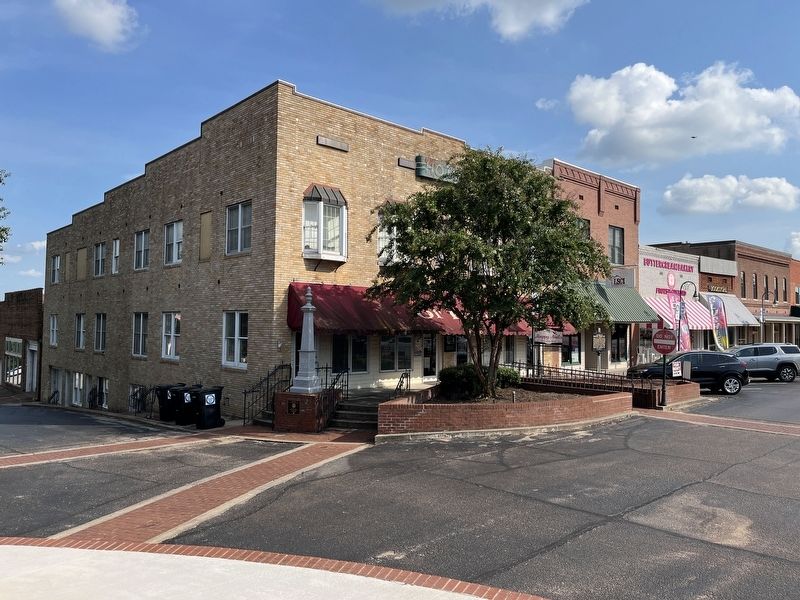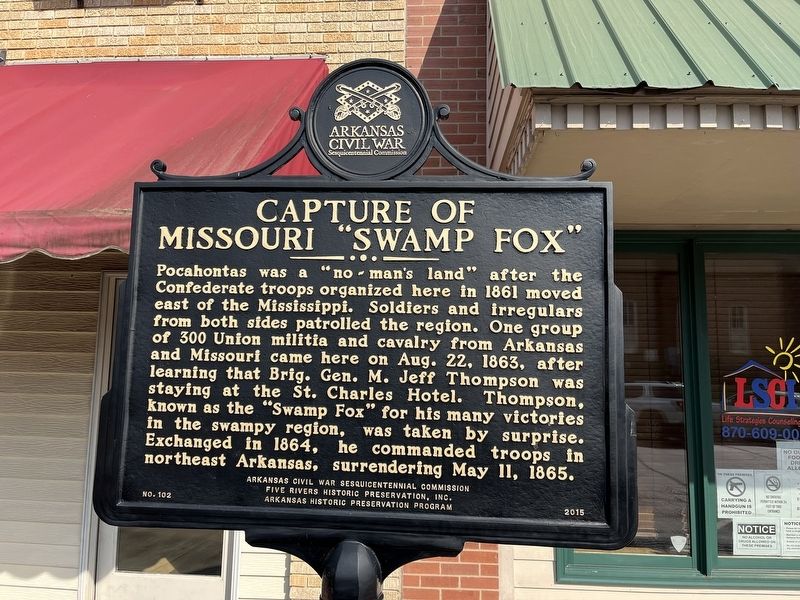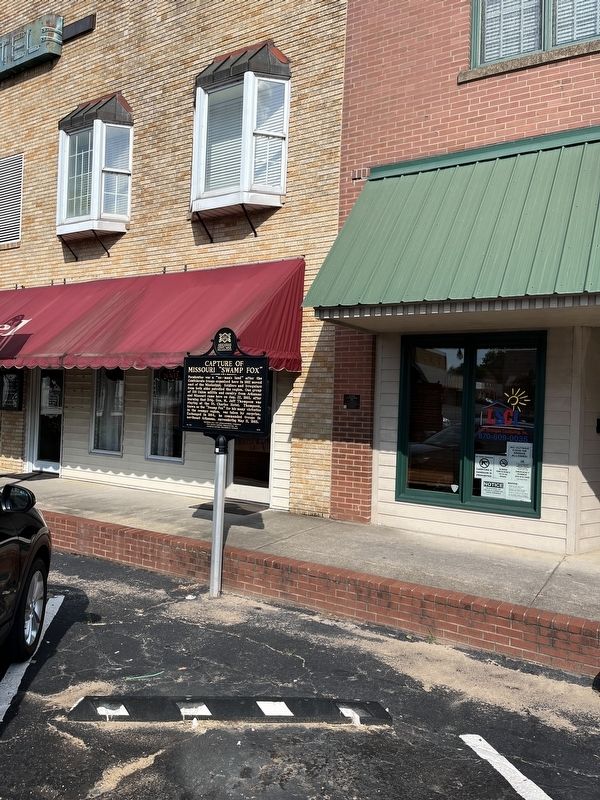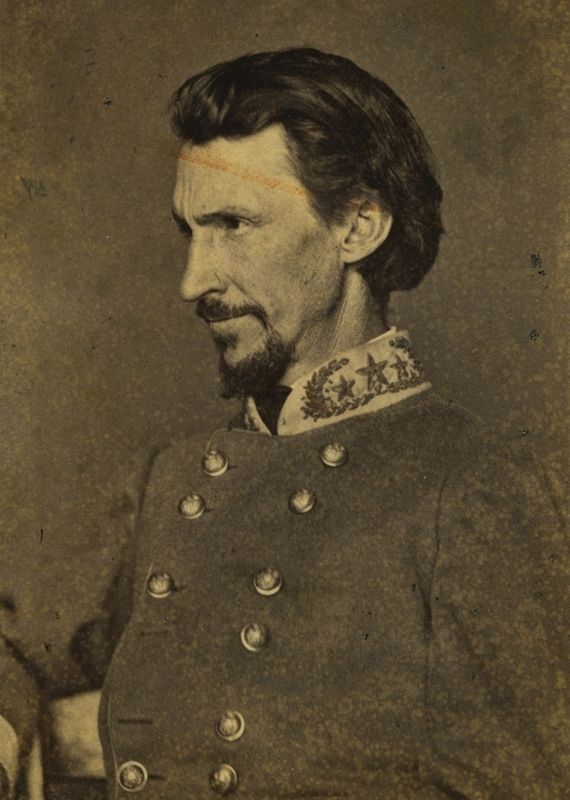Pocahontas in Randolph County, Arkansas — The American South (West South Central)
Capture of Missouri "Swamp Fox"
Erected 2015 by Arkansas Civil War Sesquicentennial Commission; Five Rivers Historic Preservation, Inc.; Arkansas Historic Preservation Program. (Marker Number 102.)
Topics and series. This historical marker is listed in this topic list: War, US Civil. In addition, it is included in the Arkansas Civil War Sesquicentennial Commission series list. A significant historical date for this entry is May 11, 1865.
Location. 36° 15.679′ N, 90° 58.186′ W. Marker is in Pocahontas, Arkansas, in Randolph County. Marker is at the intersection of North Bettis Street and East Everett Street on North Bettis Street. Touch for map. Marker is at or near this postal address: 118 N Bettis St, Pocahontas AR 72455, United States of America. Touch for directions.
Other nearby markers. At least 8 other markers are within walking distance of this marker . Site of the St. Charles Hotel (here, next to this marker); American Civil War Monument (a few steps from this marker); Lewis deMun (a few steps from this marker); The Old Randolph County Courthouse (within shouting distance of this marker); Randolph County Court House (within shouting distance of this marker); Futrell Pharmacy (within shouting distance of this marker); Spinnenweber and Peters Equine Store and Merchantile (within shouting distance of this marker); Sanitary Barber Shop (within shouting distance of this marker). Touch for a list and map of all markers in Pocahontas.
Additional commentary.
1. Short Biography of M. Jeff Thompson
Meriwether Jefferson Thompson was among the most colorful Civil War leaders. He was born in 1826 in Harpers Ferry, Virginia (now West Virginia), a son of an Army paymaster. Failing to gain an appointment to West Point, Thompson moved to Missouri as a young man and soon prospered. Just before the Civil War, he was elected mayor of St. Joseph, Missouri. In that capacity he spoke at the launch of the Pony Express and laid the groundwork for the Transcontinental Railroad.
With the Secession Crisis of 1861, Thompson followed his regional sympathies and stayed with the southern-leaning Missouri State Guard, being appointed Brigadier General in that service due to his political connections. Assigned to command the 1st Military Division of Missouri covering the southeastern part of the state, Thompson quickly established a reputation leading rapid raids. Receiving the moniker "The Swamp Fox of the Confederacy" (alluding to Francis Marion and his operations during the Revolutionary War), Thompson was a thorn in the side of federal commanders operating in Missouri and along the Mississippi River.
In early 1862, with his command driven out of Missouri, Thompson volunteered to liaise with Confederate naval forces on the Mississippi. That turned into overt command of the flotilla which he lead into action at the Naval Battle of Memphis (June 6, 1862). After that defeat, Thompson joined Confederate forces in northeastern Arkansas with the rank of colonel. Although submitted for promotion to brigadier general (commensurate with his Missouri Guard rank), this was never confirmed by the Confederate Congress.
Through the first half of 1863, Thompson served on the staff of Brigadier General John Marmaduke. Thompson's quick thinking and engineering work saved Marmaduke's command at the battle of Chalk Bluff (May 1-2, 1863). But in August, as indicated on this marker, he was captured by federals.
Thompson was among fifty high ranking Confederate officers

Photographed By Craig Swain, July 31, 2023
3. Hotel Site
The St. Charles Hotel stood at this corner. Today two adjoining brick buildings stand at the site. A hotel building, at the center of this photo, stands at the actual corner. Another building, with a plaque commemorating the site, stands to the right of that in this photo. Not clear if the hotel covered the lots where both buildings now stand.
Upon exchange, Thompson was sent back to Arkansas where he caught up to Major General Sterling Price's raid into Missouri. During that operation, Thompson took command of the famous Missouri Iron Brigade (formerly commanded by Brigadier General Joseph Shelby). At the conclusion of the raid, Thompson returned to northeast Arkansas. On May 11, 1865, he surrendered his command, being among the last Confederate forces to lay down their arms.
After the war, Thompson worked as a civil engineer in Louisiana, attempting to reclaim lands from swamps and introduce flood controls. He died in 1876 and is buried in St. Joseph, Missouri.
— Submitted September 10, 2023, by Craig Swain of Leesburg, Virginia.
Credits. This page was last revised on September 10, 2023. It was originally submitted on September 10, 2023, by Craig Swain of Leesburg, Virginia. This page has been viewed 71 times since then and 21 times this year. Photos: 1, 2, 3. submitted on September 10, 2023, by Craig Swain of Leesburg, Virginia. 4. submitted on April 7, 2021, by Mark Hilton of Montgomery, Alabama.


